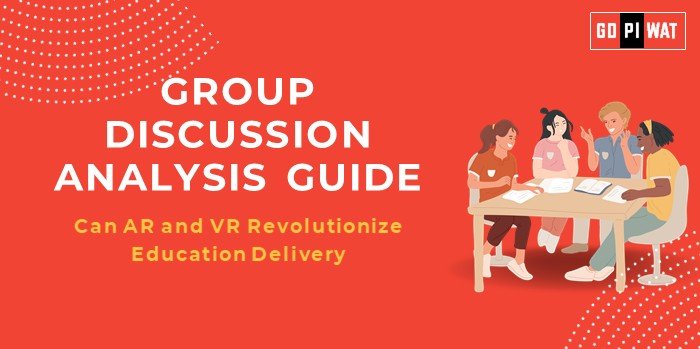📋 Can AR and VR Revolutionize Education Delivery?
🌐 Group Discussion (GD) Analysis Guide
🧩 Introduction to AR and VR in Education
Opening Context: “The rapid advancements in augmented reality (AR) and virtual reality (VR) have opened new frontiers in education delivery, redefining how students interact with content and learn.”
Topic Background: Emerging technologies like AR and VR aim to transform passive learning into immersive experiences. While simulation-based training has existed for years, AR/VR integration in mainstream education is relatively new and rapidly gaining traction.
📊 Quick Facts and Key Statistics
- 💰 AR/VR EdTech Market: $3.5 billion (2023), projected to reach $12.6 billion by 2028.
- 🏫 Adoption Rate: 40% of U.S. schools have piloted AR/VR tools in classrooms.
- 🎓 Learning Outcomes: 90% retention rate in AR/VR learning compared to 20% in traditional lectures.
- 🌍 Global Access: Only 25% of schools in developing countries have access to AR/VR tools.
👥 Stakeholders and Their Roles
- 🏫 Educational Institutions: Integrating AR/VR tools into curricula and training teachers to deliver immersive education.
- 🏛️ Government and Policy Makers: Funding infrastructure, setting ethical guidelines, and bridging access gaps.
- 💻 Tech Companies: Developing cost-effective and scalable AR/VR tools tailored for education.
- 👨👩👧👦 Students and Parents: Advocating for technology adoption to enhance learning outcomes.
🏆 Achievements and ⚠️ Challenges
🎯 Achievements:
- 📈 Enhanced engagement and retention in STEM subjects through VR simulations.
- 🧠 Real-time learning via AR tools in hybrid classrooms.
- 🏫 Case Study: Stanford’s VR courses reported a 20% increase in participation rates.
⚠️ Challenges:
- 💸 High Costs: Expensive hardware like VR headsets makes scalability challenging.
- 📚 Teacher Training: Lack of training for educators to integrate AR/VR effectively.
- 🌐 Digital Divide: Unequal access to AR/VR tools between urban and rural regions.
🌍 Global Comparisons
- 🇰🇷 South Korea: Leading in AR/VR adoption for science and engineering education.
- 🇫🇮 Finland: VR labs have shown remarkable improvements in science education outcomes.
- 🇮🇳 India: IIT Madras introduced VR modules to enhance conceptual understanding in engineering courses.
🗣️ Structured Arguments for Discussion
✅ Supporting Stance:
“AR and VR are transformative technologies that bridge the gap between theoretical knowledge and practical learning, providing immersive and engaging educational experiences.”
❌ Opposing Stance:
“The high costs and technical barriers associated with AR/VR adoption make it impractical for widespread implementation, especially in developing nations.”
⚖️ Balanced Perspective:
“While AR/VR have immense potential to revolutionize education, affordable solutions, teacher training, and infrastructure development are necessary for equitable adoption.”
🎯 Effective Discussion Approaches
- 📊 Statistical Opening: “The AR/VR education market is expected to grow to $12.6 billion by 2028, reflecting the massive potential of immersive learning.”
- 📚 Case Study: “In Finland, VR labs have significantly improved student engagement and outcomes in science education.”
- 🛠️ Counter-Argument Handling:
- Cost Concerns: Highlight open-source AR/VR tools and government-led funding initiatives.
- Training Issues: Propose government-sponsored teacher training programs for seamless tech adoption.
📈 Strategic Analysis: Strengths and Weaknesses
- ✅ Strengths: High engagement, immersive learning, practical skill development.
- ⚠️ Weaknesses: Cost barriers, digital divide, need for trained educators.
- 🚀 Opportunities: AI integration, global EdTech partnerships, hybrid learning models.
- ⛔ Threats: Cybersecurity concerns, resistance to tech adoption, and unequal access.
🎓 Connecting with B-School Applications
- 🏢 Real-World Applications: AR/VR is increasingly used in executive education and corporate training, offering innovative learning solutions.
- 💡 Sample Interview Questions:
- “How can AR/VR address traditional education delivery challenges?”
- “What are the economic implications of widespread AR/VR adoption in global education?”
- 📝 Insights for B-School Students:
- Explore AR/VR solutions in EdTech startups.
- Understand technology’s role in driving innovative learning strategies.


